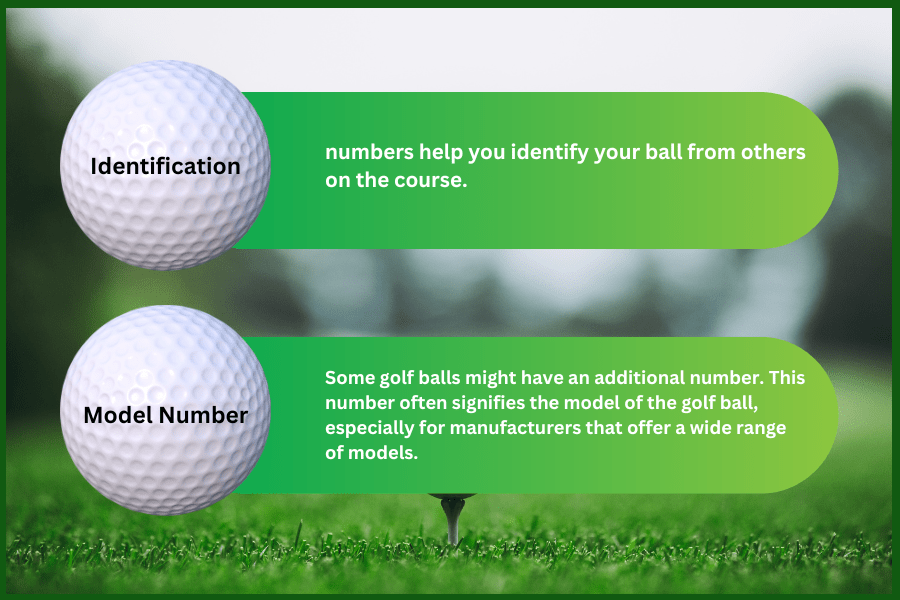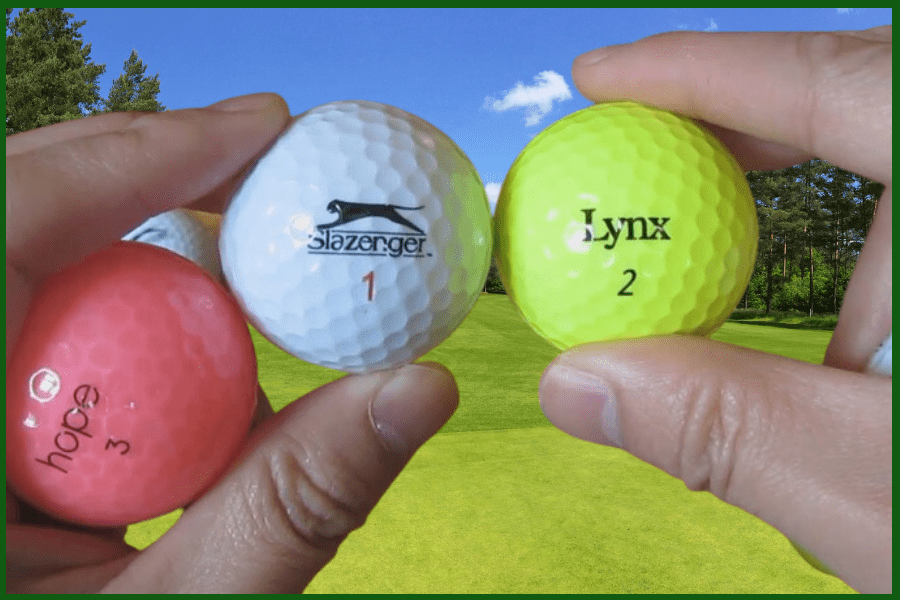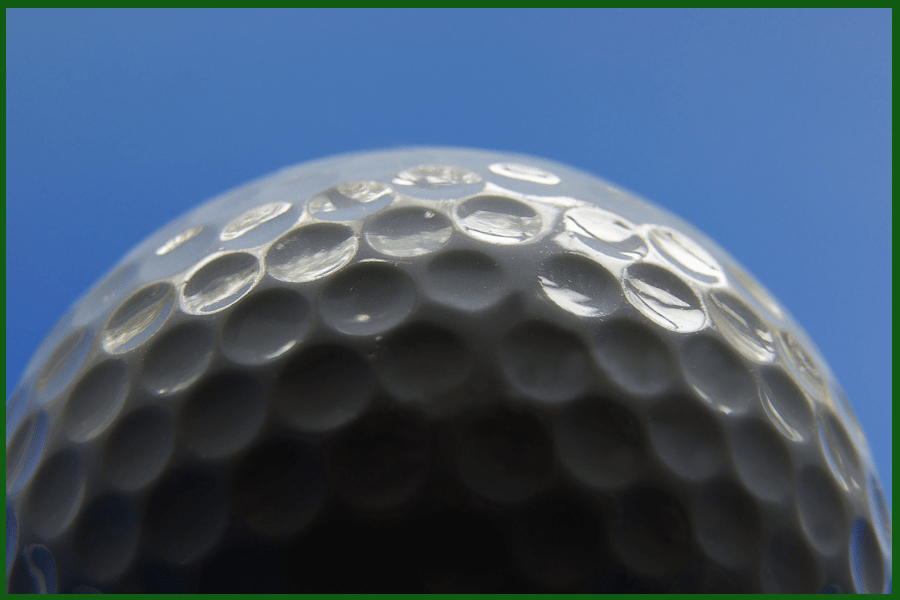Just imagine this: You’re on the green, eyeing a tricky putt, and as you kneel to line up your shot, you glance at the ball. Your gaze falls on the number inscribed there.
Does it hold some secret? Is it speaking to you about the ball’s performance, or is it just an identification tag?
Well, let me assure you, those numbers aren’t just for show; they actually hold significant information. It’s like each golf ball has a little ID card printed on its dimpled surface. This attention to detail that’s part of what makes golf such a fascinating game, is as intricate as the process of cleaning golf balls.
So, whether you’re a seasoned player looking to deepen your understanding or a newbie eager to grasp the nuances, this guide will shed light on this unexplored facet of the game.
Let’s delve into the intriguing world of golf balls and uncover what those numbers mean.
The Basics: Unpacking What The Number on A Golf Ball Means

So, what’s with the numbers?
Here’s the kicker – they’re not as mysterious as they seem.
At their core, the numbers on golf balls typically serve two primary purposes:
- Identification: First and foremost, these numbers help you identify your ball from others on the course. It’s a simple yet effective way to prevent mix-ups during play, especially when other players use the same brand of golf balls. That’s why many balls have at least one number stamped on them.
- Model Number: Some golf balls might have an additional number. This number often signifies the model of the golf ball, especially for manufacturers that offer a wide range of models. It’s another way of distinguishing between different types of balls from the same brand.
Now, these are the basics. But as with all things golf, there’s more beneath the surface.
Golf ball numbers usually come in single-digit, two-digit, or three-digit forms, each with its unique significance.
Also, have you ever thought beyond the numbers and wondered what golf balls are made of? The answer might surprise you.
Single-Digit Numbers: More Than Just a Number

Single-digit numbers, ranging from 1 to 4, or sometimes going up to 9, are the most common ones you’ll encounter on golf balls.
But what do they represent? Well, it’s simpler than you might think.
A single-digit number printed on a ball primarily serves an identification purpose.
Identification Number
When you’re out on the course, especially in a crowded game or tournament, the last thing you want is to confuse your ball with someone else’s.
So, the single-digit number comes into play here.
It’s like the jersey number on a soccer player, meant to help you easily differentiate your ball from the others.
For instance, if you’re playing a Titleist 3 and another player is also using a Titleist, but with a number 4, you can both confidently identify your own balls.
But here’s a fun fact — these numbers also hold a traditional aspect.
Player Preference
In the early days of golf, it was typical for a golfer to play a round with the same number ball as the hole they were starting on.
So, if you were kicking off your game on the 3rd hole, you’d likely pick a number 3 ball.
While this tradition isn’t as common today, some golfers prefer this for nostalgia or personal preference.
Remember, the single-digit number itself doesn’t affect the performance, characteristics, or how long golf balls last.
Whether you play with a number 1 or 4, they’ll perform identically on the course if they’re the same make and model. So, if you plan to purchase golf balls, keep in mind that single-digit numbers boil down to personal preference.
Moving up the Scale: What Two-Digit Numbers Represent

As we scale up from manufactured golf balls with single-digit numbers, these numbers’ roles can shift slightly, adding another layer of meaning.
Two-digit numbers typically range from 10 up to 99, although you’re more likely to see numbers like 20, 30, or 90.
They have two major purposes:
Model Number
Most frequently, the two-digit number represents the model of most golf balls. This is especially true for brands that produce multiple models of balls with different performance characteristics.
For example, a Titleist Pro V1 might display the number ’90’ to differentiate it from another model like the Titleist AVX.
This number helps you quickly recognize the model you are playing with, which is particularly useful when shopping for balls or discussing them with fellow golfers.
Custom Identification
Some golfers like to order balls with specific two-digit numbers that hold personal significance –– birthdays, anniversaries, or lucky numbers, for instance. It’s a way to personalize your gear and make it easier to identify on the course.
Golfing is all about personalization. It’s not only about the number on your ball, but also about the ball itself that makes a difference in your performance. If you’ve ever found yourself pondering about what golf ball you should use, you’re not alone.
Beyond the Ordinary: Deciphering Three-Digit Numbers

Stepping up another notch, we enter the domain of three-digit numbers. These are less common and can initially seem puzzling. But once you understand what they represent, they can provide valuable insight into your golf ball’s construction.
A golf ball with a three-digit number typically ranges from 100 up to 500 or more. The three-digit numbers on a golf ball often represent an approximate dimple count, a feature that could pique your curiosity about the number of dimples on a golf ball.
Contrary to the identification or model number role of the single and double-digit numbers, three-digit numbers usually have a more technical meaning:
Dimple Count
Three-digit numbers most often represent the approximate count of dimples on the golf ball. Dimples are those tiny indentations that cover a golf ball’s surface.
They play a critical role in the ball’s aerodynamics, reducing drag and helping it lift and travel farther through the air.
So, a golf ball with the number ‘332’ might suggest it has around 332 dimples.
But remember, this is an approximation. Exact dimple counts can vary slightly from ball to ball, even within the same model.
Compression Ratings
Three-digit numbers could represent the golf ball compression rating. Though this is less common today, it was once a popular way to indicate the ball’s hardness.
For instance, a ‘100 ‘suggests that the ball’s compression rating is high, ideal for players with high swing speeds.
Bonus Numbers: Logo, Custom, and Specialty Numbers
Now that we’ve demystified the single, double, and triple-digit numbers, let’s delve into other markings you might encounter on your golf balls.
These “bonus numbers” or symbols can range from logos to custom numbers and specialty identifiers.
Golf Ball Manufacturer’s Logos and Models
The manufacturer’s logo is one of the most common additional markings on a golf ball. This insignia serves as a brand identifier and provides a handy alignment aid when setting up your shot or putt.
Similarly, the model name or number is often printed on the ball, helping to distinguish between different lines from the same golf ball brand.
Custom Numbers and Logos
Many golfers enjoy adding a personal touch to their balls through custom numbers or logos. This could be a special date, initials, or a unique symbol that holds significance for you.
Not only does this help further distinguish your ball on the course, but it also adds an element of personality to your gear.
Specialty Markings
Some golf balls might have unique markings denoting a special feature or edition.
For example, Titleist’s ‘Play Numbers,’ which range from 00 to 99, gives golfers more ball identification options.
Most golf ball manufacturers might also offer limited edition numbers or symbols for particular events or promotions.
Alignment Aids
Recently, many golf ball manufacturers have incorporated features printed around the number, like additional lines or arrows. These are designed to assist with alignment for tee shots and putting.
In addition, they provide a visual guide to help you set up your shots more accurately.
Dealing with Number Duplicates: Unique Situations on the Green

Picture this: You’re having fun with your golf buddies in a golf outing, looking to make your next shot. You spot a golf ball that matches the brand and number you’re playing with, only to realize your partner is also playing the same.
Who does the ball belong to?
Picking up the wrong golf ball can seriously affect your game. So, it’s best to have a quick way to differentiate between your balls, allowing you not to pick up the wrong ball.
Marking Your Golf Balls
The simplest and most commonly adopted solution is marking your golf balls. This is a practice that many professional golfers adopt and is even recommended in the Rules of Golf.
You can add a unique mark, dot, line, or even your initials to your ball using a Sharpie or golf ball marker.
Playing Different Numbers
If you regularly play with the same group and frequently use the same brand of balls, consider agreeing to each play a different number, avoiding any potential mix-ups on the course.
Custom Numbers
Ordering golf balls with custom numbers is another option for those who want to avoid this situation altogether.
As we’ve discussed, some brands can customize the numbers on your golf balls, meaning you can choose a number you’re unlikely to encounter on the course.
Final Words: Explore the Rich World of Golf Equipment
Remember, golf is a journey, not a destination. It’s not just about the equipment but also about technique, like mastering how to hit a golf ball straight or learning to finesse your drive to hit a golf ball farther.
Keep exploring, learning, and, most importantly, enjoying this wonderful game. Golf is a journey, not a destination; each piece of knowledge adds to your enjoyment and appreciation.
Until next time, happy golfing!
About The Author

